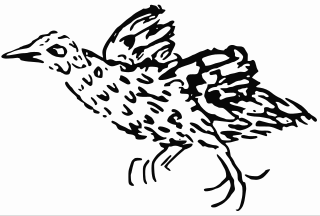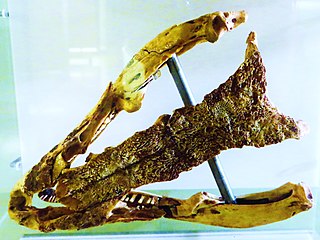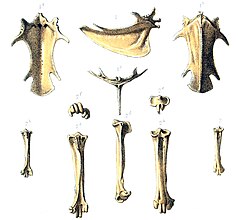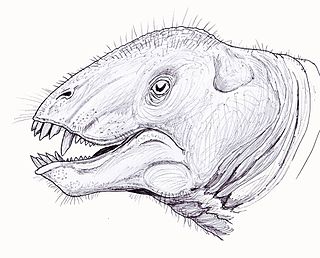 W
WThe list of extinct animals in Africa features the animals that have become extinct on the African continent and its islands, like Madagascar, Mauritius, Rodrigues, Réunion, Seychelles, Saint Helena, Cape Verde, etc. Only extinctions of the Holocene Epoch are included.
 W
WAfrocyclops pauliani is an extinct species of copepod in the family Cyclopidae. A single specimen was discovered in 1951 in a small freshwater pool near Antananarivo, Madagascar, but the species has not been seen in collections since.
 W
WThe names Atlas bear and African bear have been applied to an extinct population or populations of the Cantabrian brown bear in North Africa. The Cantabrian brown bear likely was introduced to Africa from Spain by the Romans who imported the bears for spectacles.
 W
WBrachytarsomys mahajambaensis is an extinct rodent from northwestern Madagascar. It is known from nine isolated molars found in several sites during fieldwork that started in 2001. First described in 2010, it is placed in the genus Brachytarsomys together with two larger living species, which may differ in some details of molar morphology. The presence of B. mahajambaensis, a rare element in the local rodent fauna, suggests that the region was previously more humid.
 W
WThe broad-billed parrot or raven parrot is a large extinct parrot in the family Psittaculidae. It was endemic to the Mascarene island of Mauritius in the Indian Ocean east of Madagascar. It is unclear what other species it is most closely related to, but it has been classified as a member of the tribe Psittaculini, along with other Mascarene parrots. It had similarities with the Rodrigues parrot, and may have been closely related.
 W
WCanariomys is an extinct genus of rodents that once existed on the islands of Tenerife and Gran Canaria, part of the Canary Islands, Spain. These giant rats could reach a weight of about 1 kg (2.2 lb). They were herbivores; their diet was based on plant materials, probably soft vegetables such as roots, ferns, and berries, but not grass. C.tamarani were considered herbivores, eating everything plant like except grass with good digging skills. While C.bravoi were considered as a rat character, because of its large size, with an omnivorous diet with good climbing skills.
 W
WThe Ascension crake is an extinct flightless bird that previously lived on Ascension Island in the South Atlantic Ocean. Like many other flightless birds on isolated islands, it was a rail. It was declared extinct by Groombridge in 1994; BirdLife International confirmed this in 2000 and 2004.
 W
WDiplocidaris is an extinct genus of sea urchins belonging to the family Diplocidaridae. The type species of this genus is Cidaris gigantea Agassiz, 1840.
 W
WGallotia goliath is an extinct giant lizard species from the island of Tenerife of the Canary Islands, Spain. This reptile lived before the arrival of humans and is believed to have grown to at least 0.9 metres (3.0 ft) long. It was described by the German herpetologist Robert Mertens. Fossils of this lizard have been found in volcanic caves, where they often appear with those of other animals, like the Tenerife giant rat.
 W
WThe Alaotra grebe, also known as Delacour's little grebe or rusty grebe, is an extinct grebe that was endemic to Lake Alaotra and its surrounding lakes in Madagascar.
 W
WThe Mascarene grey parakeet or Thirioux's grey parrot, is an extinct species of parrot which was endemic to the Mascarene Islands of Mauritius and Réunion in the western Indian Ocean. It has been classified as a member of the tribe Psittaculini, along with other parrots from the Islands.
 W
WThe Mauritius night heron is an extinct night heron species from Mauritius. It is only known by seven subfossil bone remains consisted of cranium, pelvis, coracoid, ulna, radius, and tarsometatarsus found in Mare aux Songes. Only the coracoid and the tarsometatarsus are left today. It was scientifically discussed in 1893 by Alfred Newton and Hans Gadow from the Cambridge University. Newton and Gadow measured the tarsometatarsus with 81 to 87 mm. It became presumedly extinct in the late 17th century and was probably first mentioned by François Leguat in 1693 who described them as a "great flight of bitterns".
 W
WThe Mauritius sheldgoose, also known as the Mauritius shelduck, is an extinct species of goose from Mauritius.
 W
WNamibcypris costata is an extinct species of ostracod crustaceans in the family Candonidae, possibly endemic to the southern Kaokoveld in northern Namibia.
 W
WNesomys narindaensis is an extinct rodent that lived in northwestern Madagascar. It is known from subfossil skull bones and isolated molars found in several sites during field work that started in 2001. First described in 2010, it is placed in the genus Nesomys together with three smaller living species, which may differ in some details of molar morphology. The presence of N. narindaensis, a rare element in the local rodent fauna, suggests that the region was previously more humid.
 W
WThe Rodrigues pigeon, also known as Rodrigues dove is an extinct species of pigeon formerly endemic to the Mascarene island of Rodrigues. It is known from a subfossil sternum and some other bones, and the descriptions of Leguat (1708) and Julien Tafforet (1726).
 W
WTapinocaninus is an extinct genus of therapsids in the family Tapinocephalidae, in which it is the most basal member. Only one species is known, Tapinocaninus pamelae .Living during the Middle Permian.